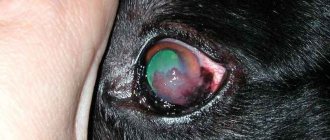Eye loss in dogs that have a specific structure of this organ, where it protrudes outward, is a common occurrence. Many owners who encounter it for the first time are very frightened. If your pug's eyes fall out, it is important to know how first aid is provided and what to do to prevent this from happening again.
Why might a pug's eyes fall out?
Pugs are at risk for brachycephaly, which is characterized by a short and flattened muzzle. In addition, the eyeballs of pug pups are very weakly supported by soft tissues and are also bulging.
However, a pug’s eyes fall out not at all because of the structure of the skull and poor support for the visual organs, but for a number of different reasons.
Causes of eye loss in pugs:
- Falling from height.
- Injury from an accident or serious fight with other animals.
- Making a sudden movement.
- Internal bleeding or infection.
- Severe stress.
- The animal was hit in the back of the head and its eyeballs fell out.
- Presence of tumors.
The idea that proptosis in pugs occurs due to sneezing is a myth.
Diagnostic methods
It is hardly possible to confuse such a state with something else.
If something like this happens to a pet, you can first understand it by its unaesthetic appearance.
In the process of moving attention between objects or people, the animal’s eyes will clearly stand out against the background of the muzzle.
In addition, it will be possible to observe the inflammatory process, redness of the eyes, as well as burst blood vessels. Against the backdrop of all the processes taking place, the appearance of the animal will be distinguished by soreness.
How to understand that a dog has proptosis
In fact, it is difficult to confuse proptosis with other diseases. Even the appearance of the pet will indicate this. In addition to apples falling out of the orbit, the following symptoms indicate proptosis:
- the membrane of the eyeball, which has fallen out, is swollen and inflamed;
- there are also hemorrhages on it;
- the cornea acquires an opaque dark color;
- a hematoma forms in the periocular area.
First aid
It is quite natural that if such a situation happens for the first time, the animal’s owners may be confused, not knowing what to do in the current circumstances.
In such a case, there is no need to panic.
Pug owners should always ensure that the simplest saline solution is always present in their home medicine cabinet..
It is unlikely that you will be able to do without this remedy if, for example, a speck gets into your pet’s eye.
Fixing the eyeball in the correct position will not be difficult.
To do this, you will need clean gauze, which should be folded several times and thoroughly wetted with the solution . Afterwards, the moistened gauze cloth should be applied to the missing eye and securely secured with a bandage.
If it happens that there is no gauze or solution available, then you can use a clean handkerchief.
A handkerchief should be moistened in salt water and also applied to the prolapsed eyeball. After these steps are completed, you should take the animal to the veterinarian, who will be able to correctly return the eye to its original place.
NOTE!
After such manipulations, the four-legged friend’s eye should be bandaged until complete recovery.
Sometimes the veterinarian is forced to stitch the dog's eyelid shut. After an appropriate period of time, the applied sutures are removed.
In order to speed up the healing process, experts recommend treating the pug's eyes with saline solution, and also using hydrocortisone ointment for this..
It is quite possible to put the eye back in place without the help of a doctor. To do this, you should first wash your hands with soap, then gently press your finger on the apple of your eye, which will allow you to return it to its place.
Then you need to moisten the animal’s eyelids and apply a sterile bandage.
If first aid is provided incorrectly or is absent, the dog’s visual organ may atrophy.
As for veterinarians, they recommend not postponing your pet’s visit to a specialist if such a problem arises.
Expert opinion
Tolkachev Andrey Mikhailovich
veterinarian
“Depending on existing opportunities, you should not put off a visit to the veterinarian for a long time. This is due to the fact that if first aid is not provided in a timely manner, then, as experience shows, the pet may become blind. At home, it is unlikely that anyone will be able to provide adequate first aid. All this is fraught with drying out of the eye and the development of an inflammatory process, which may require longer and deeper treatment.”
What to do if your pug has eye loss?
If the owner is faced with a situation where an eyeball has fallen out, measures must be taken to save the pet. But the main thing is not to give in to panic, it will only interfere with acting coherently and quickly. Yes, a pug with missing eyes looks scary, to put it mildly. But first of all, you need to think about the dog - he needs help. Further actions directly affect the outcome of events, namely whether the organ will remain in place and retain its functionality.
So, emergency first aid measures are as follows:
- It is necessary to protect the organ of vision that has fallen out from possible infection or injury. To do this, you need to wash your hands with soap and prepare a sterile bandage. It is best to soak it in saline solution. Cover the prolapsed organ with a moistened piece of bandage.
- As soon as the bandage is applied, you need to quickly get ready for the veterinary clinic.
- Throughout the journey, you must continue to moisten the bandage applied to the animal’s eyeball. But you don’t need to remove it, but rather spray it with saline solution from a spray bottle.
If your pug is twitching, it is better to take someone else with you to help. While one person holds the dog, the second will wet the bandage. Maintaining the organ's moisture will help save it in the hospital.
Brown discharge
Such discharge under the eyes indicates that the dog is not eating properly. To get rid of these secretions, you need to individually review your pet’s diet. Bad breath can also be a consequence of poor nutrition. Feed your dog a different food or eliminate certain foods.
Using special cosmetics, you can reduce brown tear marks, but you won’t be able to get rid of them 100%, especially if their cause lies in the structural features of the tear ducts.
The best treatment for pug eyes is disease prevention. Proper care of your pet's eyes will preserve visual acuity and health for as long as possible.
Prevention of proptosis of the eyeball
Eye loss in a dog most often occurs due to improper supervision. Therefore, to prevent the disease, the owner should remember the following things:
- No one should play rough with a pug.
- Do not allow excessive tension on the skin on the pug's face.
- If you see that your pug is getting into a fight, you need to try to stop it. An unsuccessful or too strong movement by an opponent can harm the dog, causing the pug's eyes to fly out.
- You should not allow your pug to wander without permission. He risks getting into trouble and getting injured.
- You must use a harness while walking. A leash with a collar causes increased pressure on the periocular area due to tension.
- Periodically, you need to take your animal for a preventive examination to the veterinarian.
- It is necessary to promptly treat your pet’s eye diseases and not forget about care. Wipe the dog's eyesight with a tea solution.
Prognosis for recovery
It is difficult to predict how proptosis will end in your pug - the outcome is individual for each dog. But remember that eye displacement itself is not a death sentence! The final outcome is influenced by complications of the condition due to additional injuries and infections.
In the best case scenario, the dog’s eye can be restored and his vision can fully return. In some cases, when the integrity of the eye muscle is damaged, vision is restored, but dogs develop strabismus or neuritis.
If a dog is blind in one eye, the animals quickly adapt to living with one. Completely blind dogs that live in a loving, caring family can also live long and happy lives.
Questions and answers
Is it true that pugs lose eyes?
Yes, they can fall out. This condition is called proptosis. A pug whose eyes have fallen out needs immediate veterinary attention. Don't forget to keep the prolapsed organ moist.
How can you tell if your dog has proptosis?
To diagnose the disease, it is enough to examine the pug. Proptosis is characterized by “falling out” of the eyeball outside the orbit. In this case, the surrounding area will become bluish in color, and the organ of vision itself will become cloudy.
If there is no veterinarian nearby
Of course, it is not always possible to seek help from a veterinarian. Therefore, if this situation occurs quite often, it is recommended to learn how to carry out first aid yourself. To do this, first of all, wash your hands thoroughly and dry them. Now you can gently press on the eyeball so that it falls into place.
Note! The eye goes back quite easily, so you don't have to put in a lot of effort. The main problem is to apply pressure in the right place. The second or third time this procedure will be much easier. Experienced dog breeders can deal with this problem within a few minutes.
When the eyeball is in place, you should close the pug's eyelid, then apply a sterile bandage. However, after this procedure you should still consult a doctor as soon as possible. If proper and timely treatment is not carried out, the eye may have to be removed.
Red squirrels
There may be three reasons why a pug’s eyes may be red:
Conjunctivitis
An inflammatory process caused by pathogenic bacteria or viruses entering the mucous membrane. With bacterial conjunctivitis, the eye becomes red and purulent discharge appears; with viral conjunctivitis, slight clear mucus appears.
Bacterial damage to the organs of vision should be treated with antibacterial drops and ointments. Perfect for this purpose:
- Tsiprolet;
- Phloxal;
- Levomycetin (drops);
- Tetracycline (ointment).
In case of a viral infection, it is enough to rinse the eyes with saline. solution until improvement occurs. If after 5 days of intensive treatment there is no improvement, be sure to visit a veterinarian.
Keratitis
With keratitis, redness of the eyes is accompanied by attacks of photophobia. The dog constantly closes its eyes in the light, and sometimes cannot open its eyelids at all.
Reference! In pugs, keratitis develops due to the growth of the nasal fold. Increasing in size, it begins to touch and damage the cornea of the eye.
In the early stages, the disease can be treated with medication under the supervision of a doctor. As it progresses, keratitis can lead to loss of vision or the vital need for surgical removal of the eye.
Entropy
Entropy is a disease caused by the appearance of an extra fold on the eyelid (most often the upper one). The eyelashes curl inward and put pressure on the eyeball. The disease can be detected only at six months of age and later. In particularly difficult cases, the problem is solved by surgical shortening of the eyelid.
Treatment of meibomitis
In most cases, especially with timely treatment, meibomitis can be cured with conservative, non-surgical methods. First of all, disinfection of the ciliary edge of the eyelid is necessary, then local medications are prescribed.
Antibacterial drops and ointments
- Albucid
- Levomycetin
- Tetracycline eye ointment
- Floxal (ointment and drops), etc.
Anti-inflammatory drugs
- Dexamethasone eye drops
- Hydrocortisone eye ointment
Combination drugs
- Maxitrol
- Tobradex
- Sofradex and others.
The duration and frequency of use is determined by the attending ophthalmologist individually, depending on the specific situation.
Vaccinations by age (table)
| Puppy age | Vaccine |
| 8 weeks | From 5 infections:
|
| 12 weeks | From 7 infections:
|
| Every 4 months | Antihelminthic prophylaxis using drugs:
|
| 1 year | From 7 infections:
Repeat annually throughout your life. |











